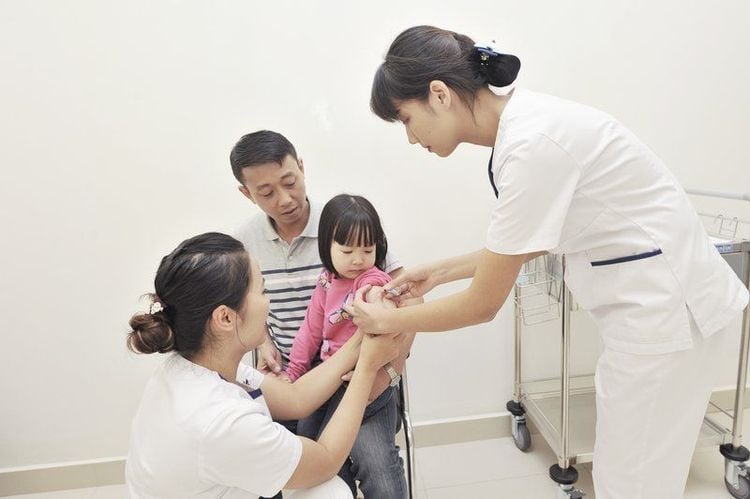This is an automatically translated article.
When it comes to tuberculosis, many people feel scared. The reason is because they do not know well about the disease, so they have a wrong view. The following article is a collection of common questions about pulmonary tuberculosis that you should know to properly understand this disease. Is this really a scary disease?
1. What is pulmonary tuberculosis?
Tuberculosis is an infectious disease caused by the tubercle bacillus (Mycobacterium tuberculosis). The disease can be found in all parts of the body such as pleural tuberculosis, lymph node tuberculosis, meningeal tuberculosis, bone and joint tuberculosis, peritoneal tuberculosis, urinary tract tuberculosis, intestinal tuberculosis, in which the disease Pulmonary tuberculosis is the most common (accounting for 80-85%) and is the main source of infection to people around.
Tuberculosis is a disease that mainly causes pneumonia caused by tuberculosis bacilli. People with severe TB disease will spread TB bacilli when coughing, etc., people around are infected by direct inhalation of TB bacteria. Although being infected does not mean that you will definitely get sick, usually your immune system will stop the reproduction of TB bacilli. If your immune system is weakened, TB bacteria will grow, and your risk of getting TB will be higher.
Trắc nghiệm: Làm thế nào để có một lá phổi khỏe mạnh?
Để nhận biết phổi của bạn có thật sự khỏe mạnh hay không và làm cách nào để có một lá phổi khỏe mạnh, bạn có thể thực hiện bài trắc nghiệm sau đây.2. How is pulmonary tuberculosis contagious?
Tuberculosis is a disease transmitted through the respiratory tract. A healthy person can be infected by direct contact with a person with pulmonary tuberculosis or with waste containing TB bacteria such as sputum, spit, saliva splashed by an infected person's cough, sneeze, etc. sharing items (towels, dishes, pots, etc.) with TB patients.
In addition, a polluted, humid living environment, eating food contaminated with TB bacteria, and coming into contact with TB-infected pets are also good conditions for TB bacteria to grow and cause disease. One person with tuberculosis coughs up bacteria that can infect 10 to 15 other people before the sick person is treated. However, once treated with anti-tuberculosis drugs, the chance of infection is very low.

Trực khuẩn lao là nguyên nhân chính gây ra bệnh lao phổi.
3. Source of infection
No reservoir of pathogens in nature or vectors of disease transmission; The source of the disease is a patient with tuberculosis of the lungs, bronchi, and tuberculosis of the larynx, who coughs up TB bacteria; When TB bacteria enter the lungs, the body will have a response to the TB bacteria's antigens, TB bacteria can remain in a person's body for a lifetime without causing disease. But it is also possible that after being exposed to a large number of TB bacteria over a long period of time for a few days to a few weeks, the exposed person can develop the disease; The period of strongest transmission is the full-blown stage of pulmonary tuberculosis (fever in the afternoon, cough much, sputum production). This transmission period lasts until the person is treated with the drug for 2 weeks to 1 month.
4. Does anyone infected with TB bacteria also get pulmonary TB?
According to statistics, only about 10% of people infected with TB germs can get TB. Healthy people are infected with TB bacteria with their body's resistance reduced due to: hard work, poor diet, disorderly living, unsanitary living environment, HIV infection... This will create conditions for TB germs to thrive in the body and cause disease.
5. Who is at risk for pulmonary tuberculosis?
People with immunodeficiency: cancer, HIV infection; Persons in direct contact with the source of infection, especially children; People with chronic diseases: diabetes, peptic ulcer, chronic kidney failure...; People addicted to drugs, alcohol, tobacco; People who use immunosuppressive drugs for a long time such as corticosteroids, chemotherapy for cancer...
6. How do you know if you have been infected with tuberculosis?
Common signs of pulmonary TB are:
Cough, sputum, sometimes blood. Cough that lasts for 2–3 weeks or more Chest pain Other common signs include tuberculosis of the lungs and other organs:
Loss of appetite Weight loss Feeling weak and tired Sometimes fever Sweating Night sweats Swelling in the neck, armpits or groin However, these signs can also be seen in many other conditions. Therefore, to be sure that this is a symptom of TB, you need to have differential diagnostic tests. If you notice one or more of these new symptoms, see your doctor.
Patients with TB often do not have all of these symptoms. Many people have only a few mild symptoms.
7. How to diagnose pulmonary tuberculosis?
To detect tuberculosis, you will be asked to perform some of the following tests:
Sputum test : when sputum smear microscopy will see tuberculosis bacteria, this is a simple and highly accurate test when diagnosing pulmonary tuberculosis. Chest X-ray helps to detect lung damage caused by TB bacteria. Tuberculin test (Mantoux test): A positive result indicates that the body has acquired immunity to TB bacteria (possibly infected with TB bacteria but not yet infected with TB). A negative result does not rule out tuberculosis. People who are malnourished, infected with HIV, may give false negative reactions.

X-quang phổi giúp phát hiện tổn thương phổi do vi khuẩn lao gây ra.
8. Can tuberculosis be cured?
Tuberculosis is treatable. However, the patient must be treated as soon as possible after the disease is detected.
Patients being treated for pulmonary tuberculosis need to adhere to the following principles:
Take medicine according to the right regimen; Take the medicine enough time; Take the medicine regularly once a day at a certain time of the day, away from meals. Patients need to re-test sputum 3 times at the following times: after the 2nd month of the initial phase of treatment, after the 5th month and after the 8th month of the maintenance treatment phase.
9. What are the consequences for patients with pulmonary tuberculosis who leave their treatment unfinished?
In the early stages of treatment, patients feel signs of disease remission, so many people voluntarily stop treatment. This is very dangerous because if the patient stops taking the drug before the treatment period, the disease does not go away, quickly recurs, and especially the tuberculosis bacteria becomes resistant to the drug, leading to later treatment difficulties. than.
10. How to prevent tuberculosis?
For people who have not yet contracted the disease:Vaccinate against tuberculosis: Vaccinate children with TB vaccine (BCG) in the first month after birth in the Expanded Immunization Program; Use a mask when going out or in contact with sick people; Cover your mouth when sneezing and wash your hands thoroughly with soap under running water, especially before eating and after using the toilet; Do not share personal items with people with tuberculosis; Keep the place clean; Periodic health examination . For people with pulmonary tuberculosis:
Wearing a mask, when coughing or sneezing must cover the mouth, spit sputum into the specified place, sputum or other objects containing infectious sources must be handled properly; Adherence; Need to go for a follow-up visit once a month; Take advantage of the sun for the patient's accommodation and belongings because TB bacteria lose their ability to cause disease in the sun. Tuberculosis is a dangerous and contagious disease. To prevent the disease, you should be fully vaccinated against TB from an early age. The International General Hospital is currently providing TB vaccination services.

Tiêm vắc xin lao tại Vinmec
The advantages of vaccination at Vinmec include:
Children will be examined by pediatricians - vaccines, fully screened for physical and health problems, counseling on vaccines - Vaccination and vaccination regimens, how to monitor and care for children after vaccination before ordering vaccination according to the latest recommendations of the Ministry of Health & World Health Organization to ensure the best effectiveness and safest for children. A team of experienced and professional pediatric doctors and nurses, understand children's psychology and apply effective pain relief methods for children during the vaccination process. 100% of vaccinated children were monitored for 30 minutes after vaccination and reassessed before leaving. Undertake medical supervision before, during and after vaccination at Vinmec Health System and always have an emergency team ready to coordinate with the vaccination department to handle cases of anaphylaxis, respiratory failure - circulatory arrest, ensuring Ensure timely and correct handling when incidents occur. The vaccination room is airy, with a play area, helping children feel comfortable as if they are walking and have a good mentality before and after vaccination. Vaccines are imported and stored in a modern cold storage system, with a cold chain that meets GSP standards, keeping vaccines in the best conditions to ensure quality. Parents will receive a reminder message before the vaccination date and their child's vaccination information will be synchronized with the national immunization information system. Vinmec International General Hospital is currently providing a Package Immunization Program with a variety of vaccines for different audiences, from infants, young children, adults, and women before and during pregnancy pregnant.
To register for child vaccination, please contact directly to Vinmec Health System nationwide or book an appointment HERE.













